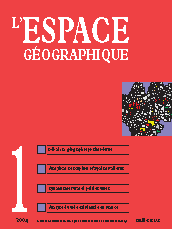

Jean-Marc BESSE. Postmodernism and geography. Elements for debate.
keywords: ARCHITECTURE, ART, CULTURE, ENGLISH GEOGRAPHY, FRENCH GEOGRAPHY, PHILOSOPHY, POSTMODERNISM, SCIENTIFIC PRACTICE, SOCIAL SCIENCES
Debate. Postmodernism and geography.
Béatrice COLLIGNON, Jean-François STASZAK. What to do with postmodern geography?
keywords: ENGLISH GEOGRAPHY, EPISTEMOLOGY, FRENCH GEOGRAPHY, POSMODERNISM, SCIENTIFIC PRACTICE
Denise PUMAIN. Post-scriptum
Debating postmodernism: some comments on chosen texts.
This article comments on four texts published in English-language reviews or books in the the 1990s. Each text sheds a different light on postmodernism. The commentary proposes a progression from the internal arguments of postmodern geographical discourse to the social (or academic) contexts shaping those arguments.
keywords: ANGLO-SAXON GEOGRAPHY, EPISTEMOLOGY, FRENCH GEOGRAPHY, POSTMODERNISM, SCIENTIFIC PRACTICE
Arthur GETIS, Jean PAELINCK. An Analytical Description of Spatial Patterns (6 tabl., 2 fig.)
The description of spatial patterns has always attracted the attention of spatial scientists, economists as well as geographers; this study takes up the problem once more but in a purely abstract fashion. On a reference area of a fractal nature one defines successively measures of concentration (or dispersion), of eccentricity, of randomness, of clustering; a visual presentation of the global results obtained can be realized through a geophenogram. Finally, two concrete examples are presented, one for five US States, the other for the twelve Dutch provinces; they show that the abstract framework developed can in fact be adapted in a flexible way to concrete situations encountered.
keywords: CONCENTRATION, ECCENTRICITY, GEOPHENOGRAM, PATTERN, RANDOMNESS
Sylvie DUBUC. Rural growth: the effect of small towns. (1 tabl., 7 fig.)
After over a century of rural exodus, and even if recent signs of a rural recovery prevail, extensive regions characterized by low population density and distance from larger cities appear to be excluded from this recovery. Maintaining population in these fragile systems is an important issue for development politics. Aveyron and Lozère, two adjacent departments south of the Massif central and within the European diagonal void, are a favourable region for study. We aimed to gain a better understanding of the factors that contribute to local development. We developed a measure of population and socio-economic growth on the micro-local scale, and a comparative analysis of roughly 500 communities revealed the local comparative advantages of the communities and their special interaction. This approach enabled us to identify and classify the major geographical factors. Differences in rural dynamics can largely be accounted for by communities relative geographical location and notably by their proximity to small towns. In some of those that are farthest from towns, the economic exploitation of local resources through agro-tourism is producing pockets of growth.
keywords: CENTRAL PLACE, GEOGRAPHICAL LOCATION, RURAL DEVELOPMENT, SERVICES, TOURISM RURAL
Book reviews
In this issue of l’Espace géographique, you will find critical reviews of the following books
BERTRAND Claude, BERTRAND Georges (2002). Une géographie traversière, lenvironnement à travers territoires et temporalités. Paris: Arguments, 311 p. (par Armand Frémont)
DEAR Michael & FLUSTY Steven, ed. (2002). The Spaces of Postmodernity. Oxford/Malden (Mass.): Blackwell, 486 p. (par Yves Guermond, Université de Rouen)
GRÉSILLON Boris (2002). Berlin, métropole culturelle. Paris: Belin, coll. «Mappemonde», 351 p., préface de Violette Rey. (par Pierrre Riquet, Université de Paris-I)
JOHNSON Nuala C. (2003). Ireland, the Great War and the Geography of Remembrance. Cambridge: Cambridge University Press, 192 p. (par Hugh Clout, University College London)
LE BRAS H. (2002). Une autre France. Paris: Odile Jacob, 224 p. (par Frédéric Giraut, Université de Grenoble)
PEYRONNIE Karine, MAXIMY René de (2002). Quito inattendu. le Centre historique en devenir. Paris: CNRS Éditions, coll. «Espaces et milieux», 335 p. (par Claude Bataillon, Université de Toulouse-Le Mirail)
MINCA Claudio, ed. (2001). Postmodern Geography. Theory and Praxis. Oxford/Malden (Mass.): Blackwell, 306 p. (par Yves Guermond, Université de Rouen)
NICOLAI Henri, PÉLISSIER Paul, RAISON Jean-Pierre, dir. (2000). Un géographe dans son siècle, actualité de Pierre Gourou. Paris: Karthala coll. «Géotropiques», 338 p. (par Hervé Théry, CNRS, UMR ENS/IRD «Territoire et mondialisation dans les pays du Sud»)
SOJA Edward W. (1989). Postmodern Geographies. Londres/New York: Verso, 266 p. (par Yves Guermond, Université de Rouen)
SOJA Edward W. (2000). Postmetropolis. Malden (Mass.): Blackwell, 440 p. (par Yves Guermond, Université de Rouen)
VODOZ Luc, dir. (2002). NTIC et Territoires. Lausanne: Presses Polytechniques et Universitaires Romandes. (par Bernard Debarbieux, Université de Genève)
Lespace géographique 4/03![]()
![]() L’espace géographique 2/04
L’espace géographique 2/04
For subscribe or buy this issue: BELIN
![]() L’Espace géographique: contents
L’Espace géographique: contents
Last modified: March 29, 2004